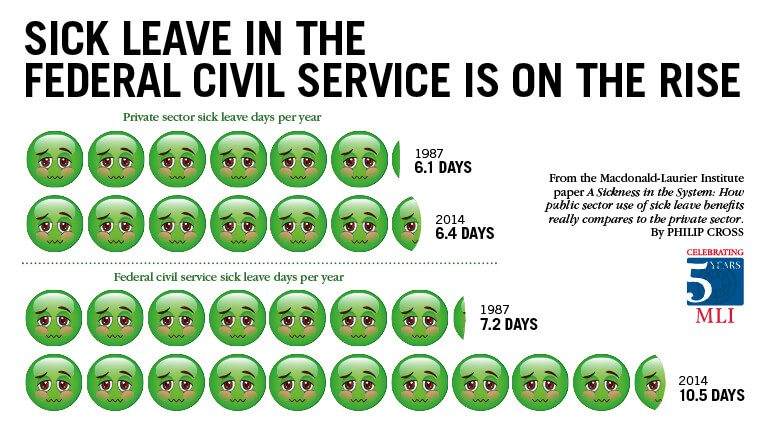The Macdonald-Laurier Institute finds sick leave use in the federal civil service dwarfs rates in the private sector
OTTAWA, Nov. 27, 2015 – The federal government’s ailing sick leave system is in need of a cure.
A new Macdonald-Laurier Institute report finds federal employees are calling in sick more often than their private-sector counterparts – and the gap is growing larger with each passing year.
Author Philip Cross, Statistics Canada’s former chief economic analyst, delves into the numbers to show federal government employees take at least two-thirds – and likely nearly twice as much – sick leave as the private sector.
“Both the level and trend of sick leave use in the federal government and throughout the public sector is troubling”, says Cross.
“The research suggests that the most important determinant of sick leave use is whether you are in the public or private sector, not your exposure to possible injury or illness in the workplace”.
To read the full paper, titled “A Sickness in the System: How public sector use of sick leave benefits really compares to the private sector”, click here.
“Both the level and trend of sick leave use in the federal government and throughout the public sector is troubling”
A growing problem
Federal employees took an average of 10.5 sick days per year in 2014, a major increase from an average of 7.2 days in 1987.
By contrast, private sector employees took only 6.4 days on average in 2014. That’s basically the same as the average 6.1 days taken in 1987.
The problem, says Cross, is unlikely that federal employees are getting sick more often.
“The research suggests a primordial role for motivation and cultural attitudes in taking sick days, rather than biology and medicine”, writes Cross.
Cross points out that there are considerable differences in sick leave use between the private and public sector even when you look at individual industries, occupations and different federal ministries.
For example: People who work indoors in the private sector, the environment most comparable to the public sector, use less than half the sick leave of the public sector.
“The research suggests a primordial role for motivation and cultural attitudes in taking sick days, rather than biology and medicine”
Unparalleled benefits
The total number of leave days available to federal workers is staggering. Cross finds that a federal employee with 30 years of experience – when you factor in vacation, sick days and other forms of leave – can take 26 per cent of his or her working days off each year.
“Needless to say, no private sector employer could compete paying its employees to be on leave almost one-quarter of the year”, he says.
Concocting a fix
To Cross, it all suggests a sick leave system that is in desperate need of reform.
He recommends the newly-elected Liberals, who have promised to repeal the previous government’s changes to civil service sick leave, try to align these benefits more closely to what employees get in the private sector.
Part of this solution, he believes, needs to address ongoing problems with long-term disability benefits. As it stands now, only one-third of employees have banked the 65 sick days needed to access these benefits.
“This is clearly a risk for employees with little seniority who have not had time to accumulate significant sick leave benefits and for people with chronic but not disabling illnesses or injuries”, says Cross.
***
Philip Cross is a Senior Fellow with the Macdonald-Laurier Institute. He previously served as the Chief Economic Analyst for Statistics Canada, part of a 36-year career with the agency.
The Macdonald-Laurier Institute is the only non-partisan, independent national public policy think tank in Ottawa focusing on the full range of issues that fall under the jurisdiction of the federal government. Join us in 2015 as we celebrate our 5th anniversary.
For more information, please contact Mark Brownlee, communications manager, at 613-482-8327 x105 or email at mark.brownlee@macdonaldlaurier.ca.





